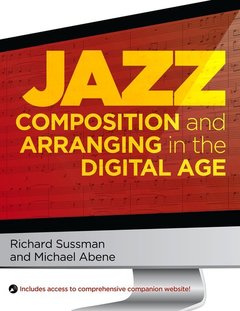Description
Jazz Composition and Arranging in the Digital Age
Authors: Sussman Richard, Abene Michael
Language: English
Publication date: 02-2012
544 p. · 27.7x21.3 cm · Paperback
544 p. · 27.7x21.3 cm · Paperback
Description
/li>Contents
/li>Biography
/li>
Jazz Composition and Arranging In the Digital Age is a comprehensive and practical instructional book and reference guide on the art and craft of jazz composition and arranging for small and large ensembles. In this book, veteran composers and arrangers Richard Sussman and Michael Abene combine their extensive years of experience as musicians and instructors to demonstrate how advances in music technology and software may be integrated with traditional compositional concepts to form a new and more efficient paradigm for the creative process. This book builds on material and issues treated in traditional jazz composition and arranging courses, including all the fundamental musical techniques and information associated with jazz arranging and composition instruction. In addition, each chapter of the book also contains specific examples demonstrating the effective utilization of music software as applied to the realization of these techniques. Software is employed both as both a learning tool in the form of examples and exercises, and as a practical tool illustrating how many modern day composer/arrangers are utilizing these techniques successfully in the real world. The book also offers several chapters devoted exclusively to the creative use of music technology and software. The extensive companion website provides listening examples for each chapter as well as enhanced software tips, expanded and additional music examples, and appendices of , basic principles and an expanded recommended listening list for further study.
Contents. Preface. -What This Book Covers. -How to Use This Book and Companion Website. Acknowledgements. Section I - Overview and Basic Information. Chapter 1 - Introduction. Chapter 2 - A Brief Overview of MIDI and Music Software. Chapter 3 - Basic Information. Chapter 4 - Fundamental Musical Considerations. Chapter 5 - Introduction to Music Notation Software. Section II - Arranging For Small Jazz Ensemble . Chapter 6 - Overview of Small Ensemble Writing/Rhythm and Rhythmic Notation. Chapter 7 -Melody aamp, Melodic Development (3-4 Horns). Chapter 8 - Basic Harmonic Concepts (3-4 Horns). Chapter 9 - Reharmonization of Approach Tones (3-4 Horns). Chapter 10 - Melodic Reharmonization and Counterpoint (3-4 Horns). Chapter 11 - Form and Planning the Arrangement/Instrumentation. Chapter 12 - Dynamics aamp, Articulations. Chapter 13 - The Rhythm Section. Chapter 14 - Completing the 3-4 Horn Arrangement. Chapter 15 - Notation Software: Generating Parts, Page Layout, aamp, Printing. Chapter 16 - Arranging For 5-6 Horns - Harmony and Chord Voicings. Chapter 17 - Form and Planning the Arrangement (5-6 Horns). Chapter 18 - The Soli and Shout Chorus. Chapter 19 - Completing the 5-6 Horn Arrangement. Section III - Arranging For Large Jazz Ensemble . Chapter 20 - Overview of Large Ensemble Considerations. Chapter 21 - Unison aamp, Octave Writing/Monophonic Texture. Chapter 22 - Concerted Writing For Brass. Chapter 23 - Concerted Writing For Saxes. Chapter 24 - Big Band Instrumental Subdivisions. Chapter 25 - Form and Planning the Arrangement. Chapter 26 - Modern Harmonic Concepts aamp, Voicing Techniques. Chapter 27 - More on Modern Harmony, Melodic Reharmonization, aamp, Counterpoint. Chapter 28 - Woodwind and Brass Doubles and Mutes. Chapter 29 - Line Writing and Polyphony. Chapter 30 - The Soli Section (Big Band). Chapter 31 - The Shout Chorus (Big Band). Chapter 32 - Arranging For Vocalists and Instrumental Soloists. Chapter 33 - Completing The Big Band Arrangement. Chapter 34 - Review of Music Notation Software Techniques. Appendices (On the Companion Website). A. Summary of Basic Arranging and Voicing Principles. B. List of Recommended Scores and Recordings for Study. C. Bibliography. Index.
In addition to his many accomplishments as a jazz pianist, composer, and arranger, Richard Sussman has also achieved widespread acclaim as a jazz educator, clinician, and music technologist. He has been a member of the Jazz Composition faculty at Manhattan School of Music for over 25 years, where his duties have included teaching undergraduate and graduate level courses in jazz arranging, as well as the direction of all aspects of Music Technology and Software within the Jazz Program. Richard Sussman received the prestigious ASCAP award for Jazz Composition in 2008, honoring jazz legend Hank Jones. Richard went on to work as an arranger with Hank on several projects, including a concert with the acclaimed Metropole Orchestra of Amsterdam. Richard was the last arranger to work with Hank Jones prior to his passing in May 2010. Michael Abene is widely acknowledged to be one of the greatest living jazz composer/arrangers, and the list of artists he has collaborated with reads like a modern day "Who's Who" of jazz. Michael is also a greatly respected jazz educator. In addition to teaching jazz composition and arranging at the Manhattan School of Music, Mr. Abene co-directed the BMI Jazz Composers Workshop for many years. He is also a much sought after guest conductor and clinician. Michael has been director of the esteemed WDR Radio Big Band of Cologne, Germany since 2003. .
© 2024 LAVOISIER S.A.S.




